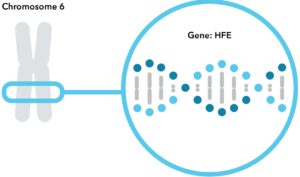Editor’s Note: This post does not reflect the current product offering for customers in the United States.
Mutations in the HFE gene cause most forms of hereditary hemochromatosis – a common genetic condition that increases a person’s risk for iron overload and can lead to liver disease, arthritis and heart problems. HFE-related hemochromatosis is recessive, meaning that you must inherit a mutated gene from each parent to have the condition.
23andMe customers have long been able to find out their results for two hemochromatosis-causing mutations in the HFE gene: the C282Y mutation and the milder H63D mutation. We’ve now updated our report to include results for a third mutation (S65C) in the genetic results table. The report was also updated to reflect current scientific consensus and to be clearer for our customers.
All three of these mutations are relatively common – 10-30% of people with European ancestry have at least one of them. But only people with two copies of C282Y (or one C282Y mutation plus one H63D or S65C mutation) are prone to accumulating too much iron.
Why is Hemochromatosis so Common?
Roughly one in 300 people with European ancestry has hereditary hemochromatosis. Rates are even higher in certain groups such as Irish, Australian, and Swedish.
The fact that hereditary hemochromatosis is so common has prompted scientists to speculate that despite the dangers of high iron levels, there was at some point in the evolutionary past an advantage to having the genetic change that underlies this condition.
Several (currently unproven) theories have been proposed.
- Variation in the HFE gene arose as people began farming and increased their consumption of cereal grains, which are lower in iron than red meat that predominated in stone age diets.
- Increased iron levels were advantageous because they protect women against iron deficiency brought on by menstruation and childbirth.
- Another theory takes into account the fact that hemochromatosis actually leads to a reduction of iron levels in a certain immune cell (the macrophage), which in turn may have given people an advantage by making them resistant to certain infections.
It can sometimes be confusing to interpret your results for this condition because most people prone to iron overload never show outward signs of the condition. Symptoms also vary widely – from fatigue, to hormone problems, to heart and liver disease – and are influenced by a person’s mutation type, sex, and diet. Age also plays a big role since iron can accumulate in the body over time – if symptoms develop at all, they typically appear later in life between the ages of 40 and 60 in men and after menopause in women.
So what does it mean if you have two mutations linked to hemochromatosis and what should you do with this information?
The short answer is that further testing is recommended. Physicians can order blood tests to measure transferrin saturation and serum ferritin levels in blood, which together provide a good picture of iron absorption and storage in the body. If these markers are elevated, additional testing to determine the impact on organs may also be warranted.
The good news is that the serious symptoms linked to this condition are very rare and highly preventable. Finding out that you have two mutations in the HFE gene early in life can help you make lifestyle changes under the guidance of your physician – forgoing iron supplements and cutting back on iron-rich food – and/or undergo simple treatments to prevent symptoms from developing in the future.
Find out more about Hereditary Hemochromatosis here.
July is National Hemochromatosis Month. Check out other posts on this condition:
–Learning About My Risk for Iron Overload
– The Iron Scale: Factors Tipping Towards Overload
– Battling Against A Common Genetic Disease
– The Most Common Genetic Disease



